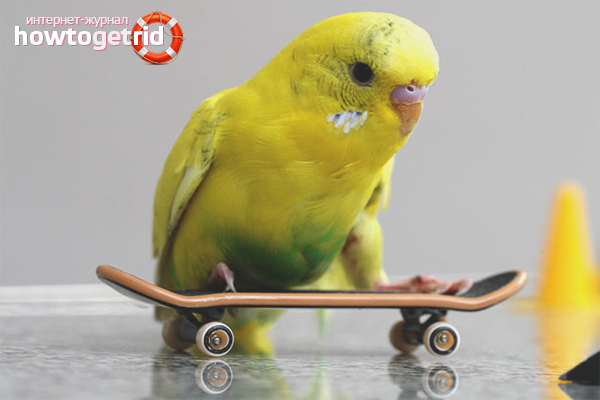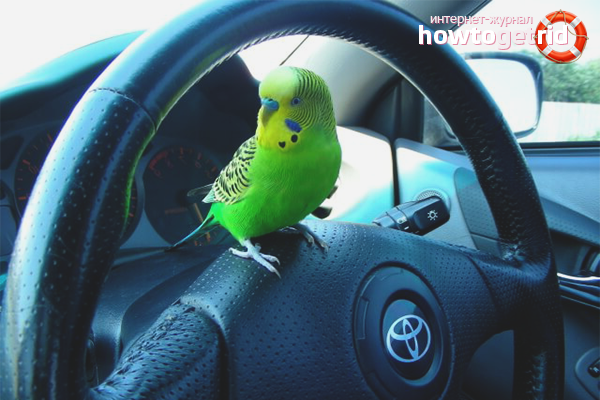The content of the article
When a feathered pet appears in the house, it becomes almost a member of the family. I don’t want to part with a parrot even on vacation and on long trips. In this case, the question becomes relevant - how to transport a parrot in a car. Also, trips in a car are necessary when visiting a veterinarian, when moving, or simply when going on a picnic.
Most parrots are very sensitive to cold and draft. A slight wind can cause them to catch a cold. Therefore, during the trip it is very important to observe some rules for transporting birds. In general, parrots quickly get used to everything new. If traveling is a routine for you, then after a few trips the parrot will get used to it and stop being afraid. In the meantime, moving for him is something new and dangerous, you need to help your friend survive the transportation with minimal stress.
What to carry a parrot
This is the most common question with the owners. You cannot carry an animal in an ordinary cage. The fact is that during transportation the car can accelerate sharply or slow down, pits and bumps can appear on the road. In this case, the bird can simply hit the bars of the cage and damage its wings. In addition, the open bars of the cage allow the parrot to see landscapes flickering outside the window. This can scare the bird.
Small parrots can be transported in special carriers for transporting birds. They are cardboard boxes with slots for oxygen on several sides. Typically, factory bird carriers have three blank walls, and the fourth is a trellis. Place the box so that the open part of the carrier does not go out the window and the bird is not afraid.
You can make such a carry yourself. For this, any box available at home is suitable. Make a few holes in it and the carrying is ready. Just pay attention to the fact that the box should be odorless. It should not be a container from detergents, from smelling leather shoes. We all know how parrots are sensitive to odors. If a person feels a light aroma, then for a bird the smell will be unbearable. From poisoning toxins.
For large cockatoo-type parrots, a special carrying for cats may be appropriate. Simple plastic baskets with lids, which we often take for picnics, are very convenient. They are harmless and have openings for good ventilation.
How to fill the carrier
The carrying bottom, boxes or baskets should be covered with a soft cloth so that the feathered feet do not slip. A small drinking bowl on suction cups is installed at the bottom. It is best to choose deep drinkers that will not spill when moving. Be sure to sprinkle some of your favorite treats in the feeder. If the trip is long (more than an hour), you can make a small perch for the parrot. So your pet will not get bored.
In advance, a few days before the trip, you need to transfer the parrot for some time to his transport house. This will allow him to adapt to a new place and on the road he will be less nervous.
On long trips, do not forget to clear the litter from the bottom of the carriage.
How to ride with a parrot
When transporting a parrot, it is very important not to open the windows so that there are no drafts. If you transport a bird in the cold season, you need to warm up the car in advance and only then bring the parrot into the cabin. Before you take out the box from the house, you need to cover it with a blanket. Open the blanket only in a warm, warm machine. In the warmer months, cover the bird with a cloth before carrying it in an open carrier.In no case do not carry the box with the parrot in the bag - the loud rustling of the bag can scare the feathered.
When a parrot is in the box inside the car, the driver should drive as carefully as possible, without sudden movements, bypassing the pits. This is a simple safety technique for a parrot - after all, a bird cannot fasten its seat belt. One sharp braking can injure the bird. It’s best to keep a box with a parrot on your hands in the back seat. If the driver is traveling without companions, the carrier is fastened with seat belts so that it shakes less.
During the trip, talk to the bird kindly, it perfectly understands the tone of the person. With the help of voice you can calm an anxious pet. If the trip is very long (more than three hours), make sure that the bird does not suffer from thirst. The parrot may stop drinking from excitement. If the water in the bowl remains at the same level, dip a finger in the water and insert it into the carrying case. The parrot instinctively pecks a finger and a small amount of moisture gets into its beak. You can also take along a few branches of dill, because it has a lot of moisture. Watch the temperature of the bird. If the plumage and head of the parrot become hot, gently wipe the pet with wet fingers. This is especially true if you transport the bird in the hot season.
When transporting a bird from one city to another, you may need a veterinary certificate stating that the parrot is vaccinated and not dangerous to others. Therefore, before traveling and moving, find out about the rules for living with animals in a future place.
The condition of the bird during the move depends on its nature. Some parrots generally calmly relate to any event, including a trip. Others, on the contrary, are very shy and rush about in the cage throughout the trip, even if you did everything right. In this case, upon arrival at the place you will see a tormented and intimidated bird. But do not worry! A couple of days of adaptation in a new place, enhanced nutrition, care and affection - and your pet will come to its senses.
The first trip by car to the bird is an exciting and dangerous event. The parrot is afraid of everything new and unusual. But after just a few trips, your pet will feel safe. Make the move as comfortable as possible for your pet!
Video: how to bathe a budgie











Submit